Over the last few months, ASUS has upgraded two of its most popular WiFi 6 routers to the Pro version and after testing them, I noticed that there are some striking similarities between them, mainly in terms of internal components. But why is the ROG GT-AX6000 in this comparison?
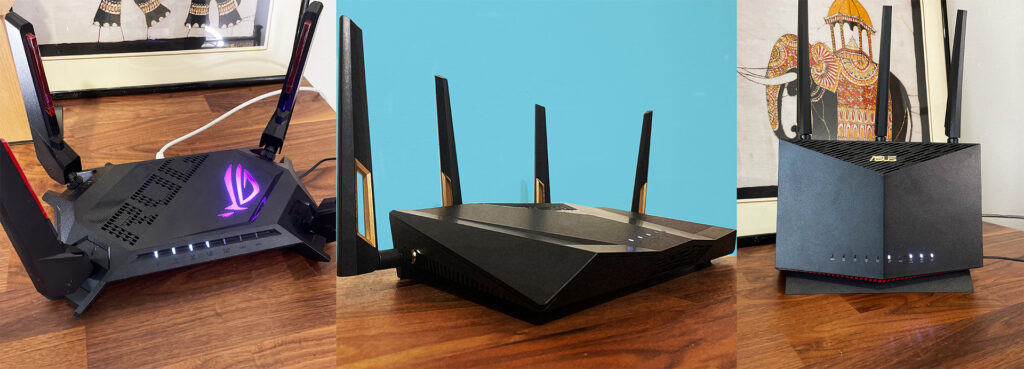
Well, this WiFi 6 router was actually the testing ground for some of the upgrades found on the RT-AX88U Pro and the RT-AX86U Pro, so despite being a bit older, it’s still a very much relevant device, still fully supported by ASUS, regularly receiving new features. And I did some brief casual comparisons between some of these routers in my videos, but didn’t truly go in depth. Now it’s time to do just that and choose which router of the three is the best option out there.
The Design and Build Quality
Let’s start with the design and build quality. When you put these three routers side-by-side, if it wasn’t for the logo, you couldn’t tell they’re built by the same manufacturer. The GT-AX6000 has this huge footprint and four antennas, one on each corner, while the RT-AX88U Pro has a more traditional look, with its antennas positioned near and on the rear side.

And it’s a design that was passed down for generations, down from the RT-AC88U. The RT-AX86U Pro has also some history, this upwards case evolved from the popular AC68U. There are three external antennas on the RT-AX86U Pro, while the fourth lies inside the case. And yes, you can upgrade the antennas on all three WiFi 6 routers.
As for status LEDs, all three routers have them positioned in the front, while the ports sit on the rear side. The ROG GT-AX6000 has two USB ports, one 2.0, the other 3.0, four Gigabit LAN ports and another two 2.5GbE ports, one for WAN and the other LAN, but do keep in mind that there is support for dual-WAN.
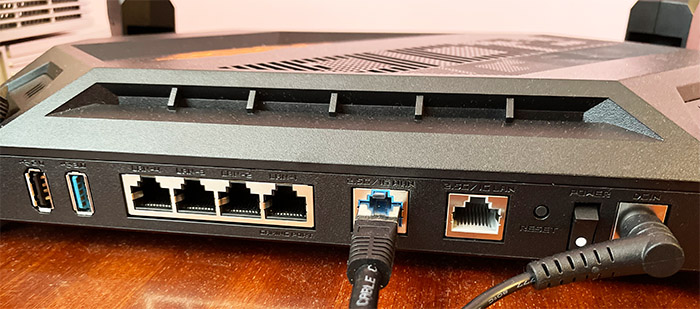
The RT-AX88U Pro and the RT-AX86U Pro have pretty much the same setup, four Gigabit LAN ports plus other two 2.5GbE ports.
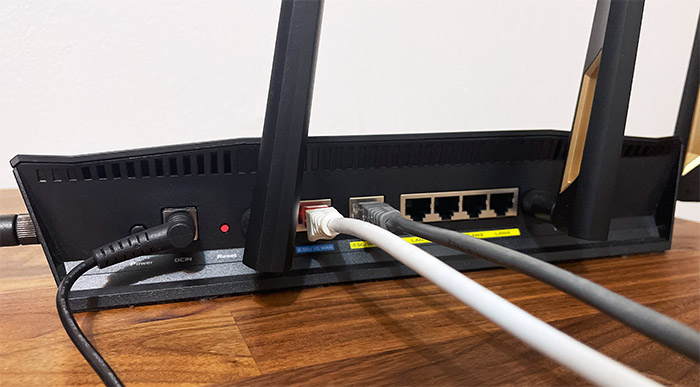
And both do offer a couple of USB ports, also 2.0 and 3.0. I do think it’s time to push for 2.5GbE on all ports, but then again, at least we get a couple of them on each router unlike on the TUF-AX4200 which has only a single one available.
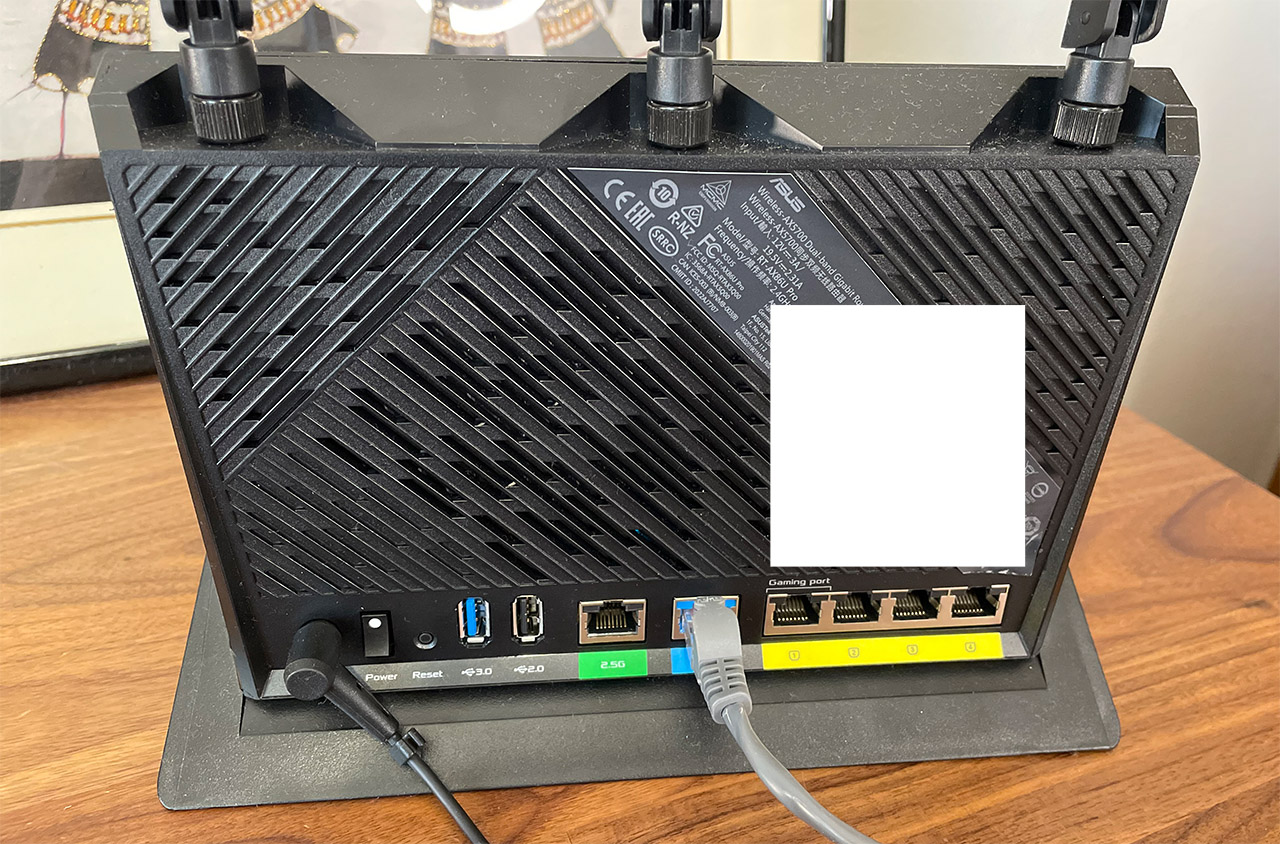
Now let’s talk about whether it’s possible to mount any of these routers on the wall. Surprisingly only one of them has this option available and yes, I am talking about the ROG GT-AX6000. People still find it baffling that ASUS has added what looks like mounting holes on the RT-AX88U Pro, but there is no place where to insert the head of a screw, it’s flat.
As for the RT-AX86U Pro, the WiFi router is vertical with a large base at the bottom, so it’s not a really wall-mounting-friendly design. So, design-wise, even if it’s the weirdest looking one, the GT-AX6000 is better than the other two router. That is, unless you don’t have a lot of space available, so the small footprint of the RT-AX86U Pro will be an advantage.
The Heat Management
When I tested the three routers, I did record some videos of their thermal management and you can see for yourself how well each device did. All three routers rely on passive cooling and while I didn’t see any hot spots, there is one device that slightly stood out a bit.

Not by much, but yes, the ASUS RT-AX88U Pro seems to be just a tiny bit better at the heat management than the other two routers which seems to be pretty much even.
The Teardown
Now let’s have a look at the main internal components of each router and see which one is the best equipped one. All three have the same quad-core 2.0GHz Broadcom processor and also the same amount of RAM which is excellent for running VPNs.
As for the storage, the RT-AX88U Pro and the RT-AX86U Pro have 256MB available, while the GT-AX6000 has double that amount. In terms of WiFi chipsets, the GT-AX6000 is equipped the same as the RT-AX88U Pro, while the RT-AX86U Pro is slightly downgraded when it comes to the 2.4GHz radio. It’s a 3×3 MIMO versus 4×4 on the two other routers.
| ASUS RT-AX86U Pro | ASUS RT-AX88U Pro | ASUS ROG Rapture GT-AX6000 | |
| CPU | quad-core 2.0GHz Broadcom BCM4912 | quad-core 2.0GHz Broadcom BCM4912 | quad-core 2.0GHz Broadcom BCM4912 |
| RAM | 1GB (2X Samsung SEC 234 K4A4G165WF) | 1GB (2x Samsung SEC 310 K4A4G16) | 1GB (2X 512MB) SKHynix (H5AN4G6NBJR) |
| Storage | 256MB MXIC (MX30LF2G28AD-TI) | 256MB MXIC (MX30LF2G189C-TI) | 512MB MXIC (MX30LF2G28AD-TI) |
| Switch | Broadcom B50212EB1KMLG PHY | MaxLinear MXL SLNW8 2.5GbE Ethernet PHY | Broadcom BCM50991E |
| 5GHz Radio 1 | Broadcom BCM6715KFBG 802.11a/n/ac/ax 4×4:4 | Broadcom BCM6715KFBG 802.11a/n/ac/ax 4×4:4 | Broadcom BCM6715KFBG 802.11a/n/ac/ax 4×4:4 |
| 2.4GHz Radio | Broadcom BCM6710KFFBG 802.11a/b/g/n/ax 3×3:3 | Broadcom BCM6715KFBG 802.11a/b/g/n/ax 4×4:4 | Broadcom BCM6715KFBG 802.11a/b/g/n/ax 4×4:4 |
Will this make a difference? We’ll see soon in the testing sections.
The WiFi Features
But before that, it’s worth mentioning that all three routers support OFDMA to help improve the latency, there’s MU-MIMO and Beamforming. Additionally, there’s support for the 160MHz channel bandwidth and, of course it is possible to use any of the three routers as either mesh node or mesh router.
The WiFi Performance
I did test each of these WiFi 6 router some more in-depth than others, so feel free to check them out since not all will be covered here. Now, let’s start with single-client test results. The client was a WiFi 6 device and I used both the 80MHz and the 160MHz channel bandwidth.
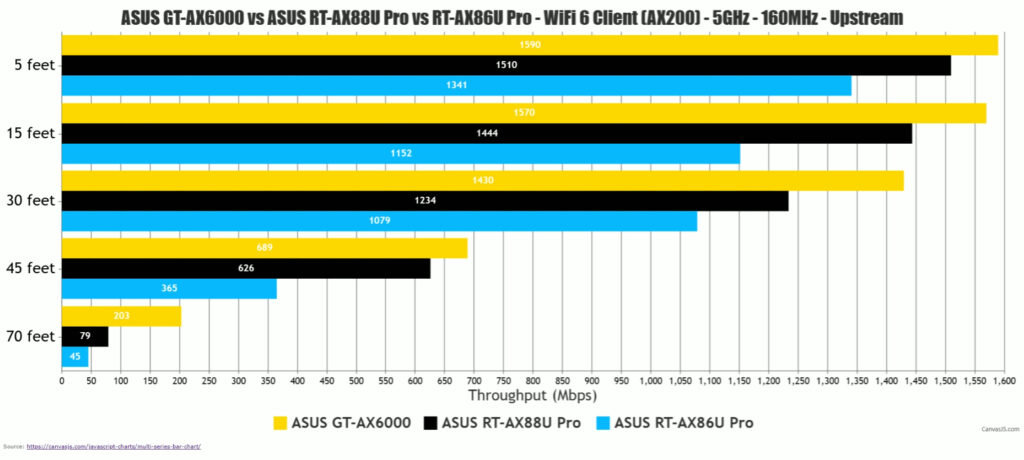
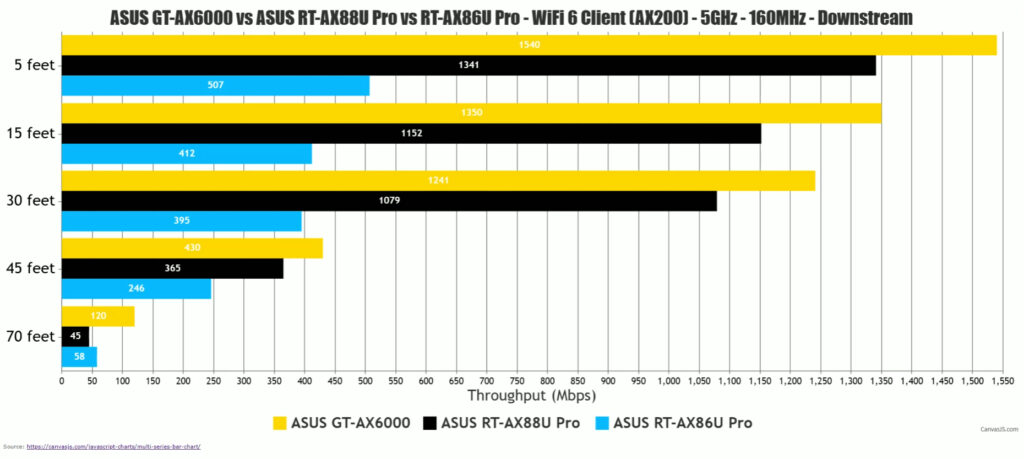
At 5 feet, we can see that the winner is the ROG GT-AX6000 both upstream and downstream regardless of the channel bandwidth.
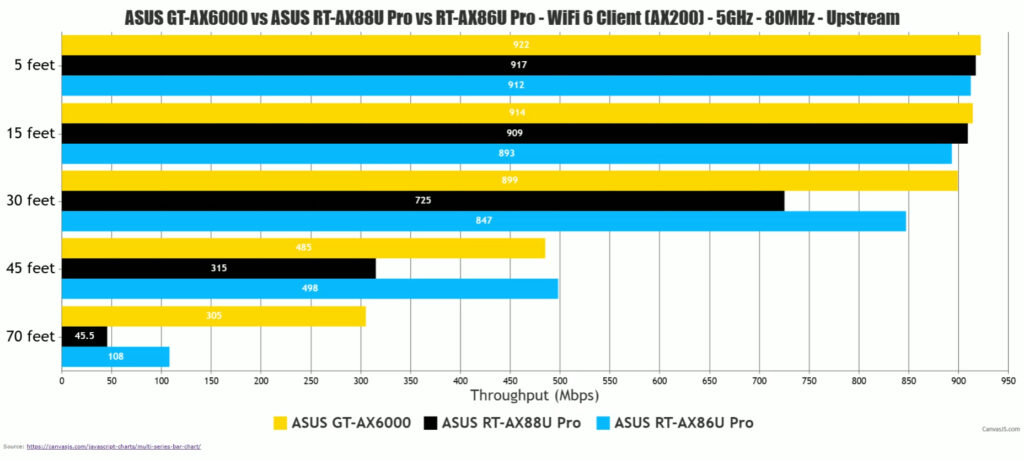
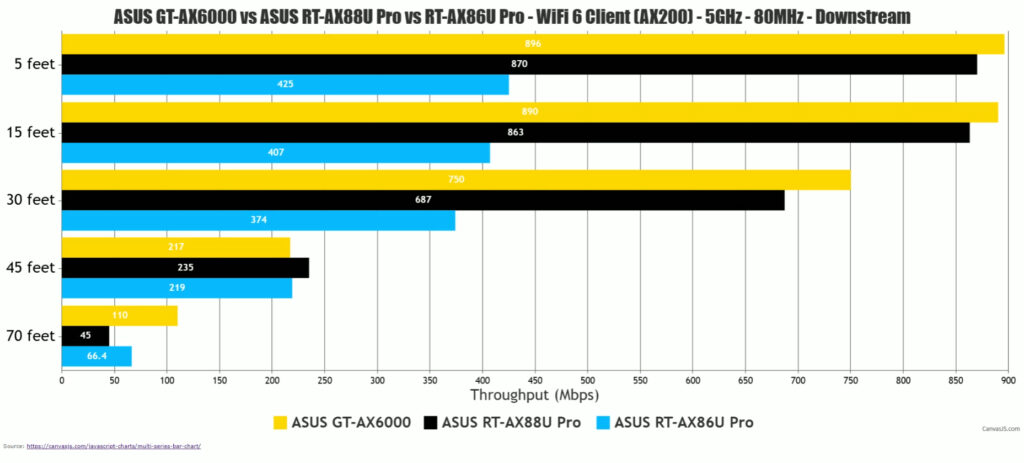
The RT-AX88U Pro is a close second when using the 160MHz width both upstream and downstream, but it does go to the third place on the 80MHz channel width, being outshone by the RT-AX86U Pro. Now let’s talk about range. I could rely on these graphs to get an idea about which offers the best throughput at 70 feet, but it’s not really a good idea because it doesn’t take into account the interference.
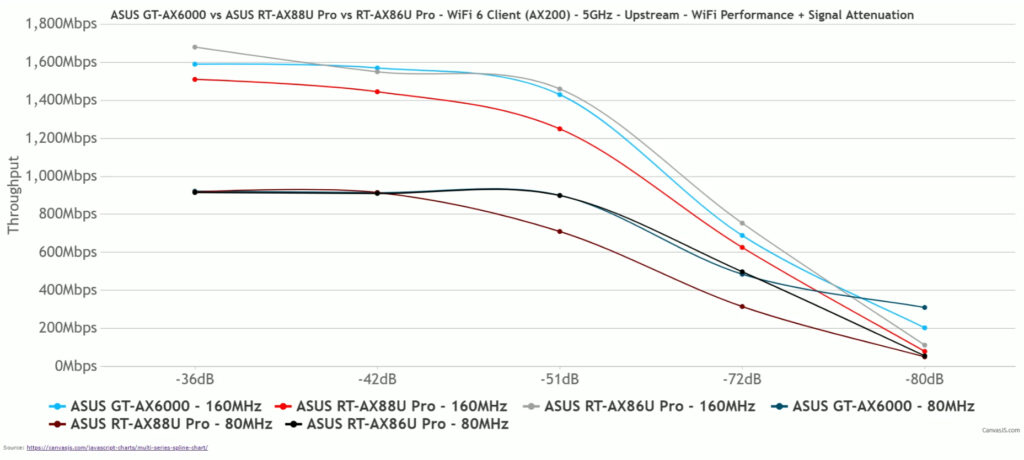
I could get a certain throughput today and tomorrow, some conditions can change such as the number of WiFi devices in the area and I could end up with a different result altogether. Also, you can’t reproduce these results in your own home unless you follow the signal attenuation and not the distance.
That’s why we’re going to check out the signal attenuation graphics. All that talk and the winner is again the GT-AX6000 which offers really good value even if the attenuation was -80dB (the equivalent of about 70 feet in my house). The worst value have been delivered by the RT-AX88U Pro and The RT-AX86U Pro when using the 80MHz channel bandwidth. All that was upstream, but let’s see what happened downstream.
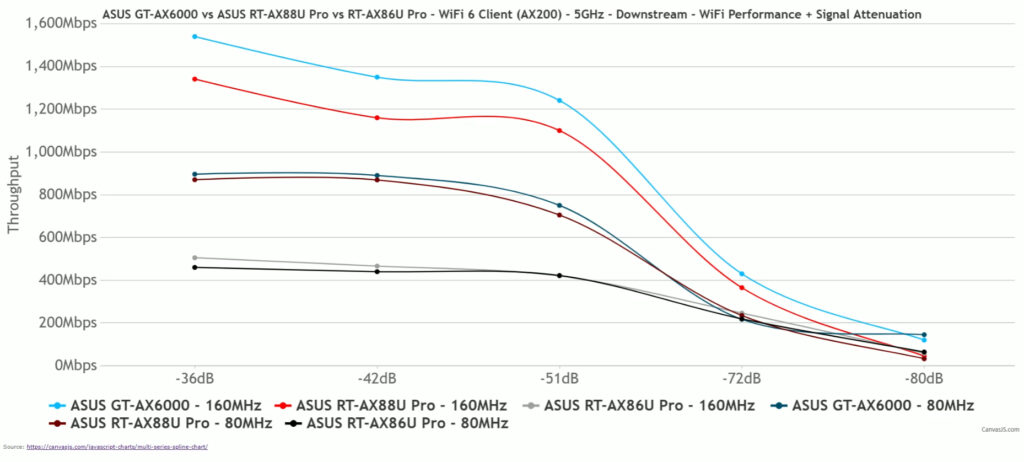
Yep, the ROG GT-AX6000 wins again, while the two Pro routers struggle to offer a decent throughput. Now let’s move to the 2.4GHz radio because while it’s mostly left for smart IoT devices, it’s still very much relevant. And things are a bit different here.
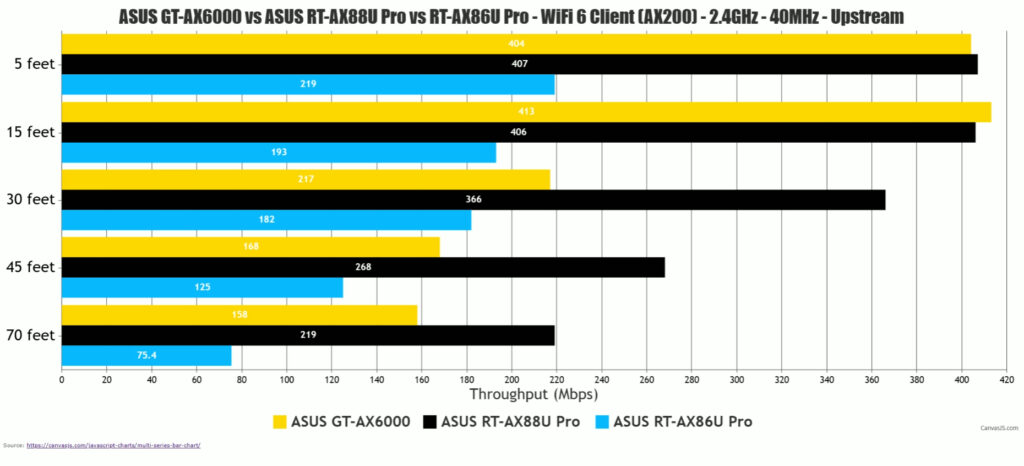
The GT-AX6000 and the RT-AX88U Pro are evenly matched up until the 30 feet mark where the latter performs much better and that remains true up to 70 feet. The RT-AX86U Pro just wasn’t able to keep up at all. And this is also confirmed by the signal attenuation graphic where we see that the RT-AX88U Pro is the clear winner in terms of range.
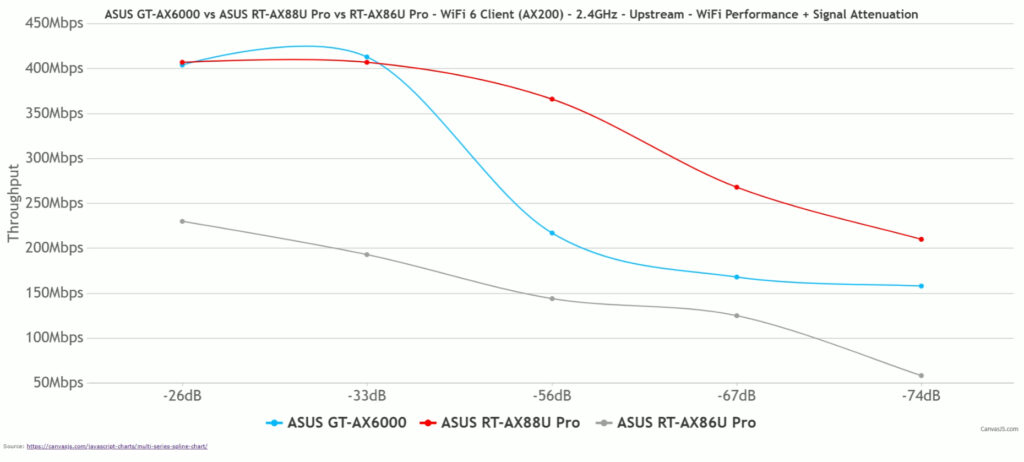
Now let’s move forward to some multi-client tests. I used the same five client devices that I always use for these type of tests and the same server PC. And since the entire chart would have been a mess if I put all the values I got, I decided to rely on the mean latency that I measured at each client level. And the results were a complete surprise. I first simulated the simultaneous 1080p streaming on five clients and we can see that the RT-AX88U Pro and the RT-AX86U Pro did really well especially on the WiFi 6 and 6E clients which remained very close to 50ms.
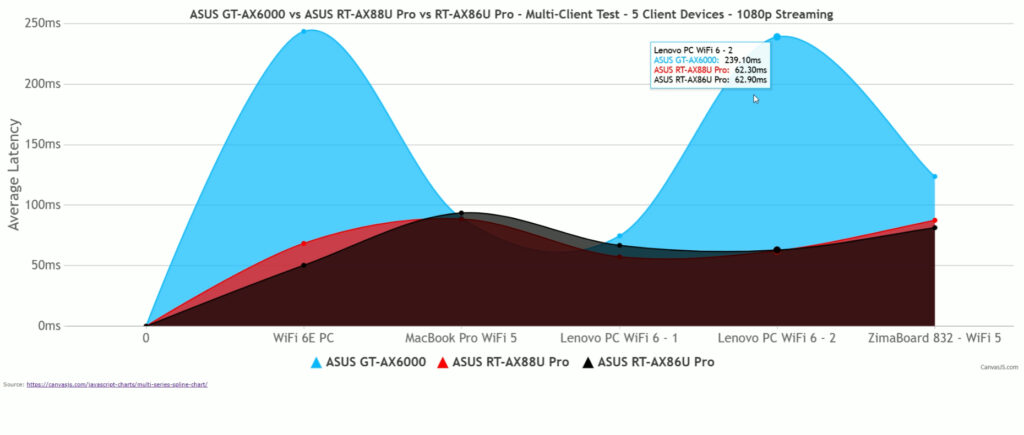
The GT-AX6000 did not do very well, which was unexpected considering the previous results. The 4K simultaneous traffic simulations reveal a very similar pattern and while I wasn’t impressed by any of the results, the GT-AX6000 displayed unreasonable latency levels on at least two client devices.
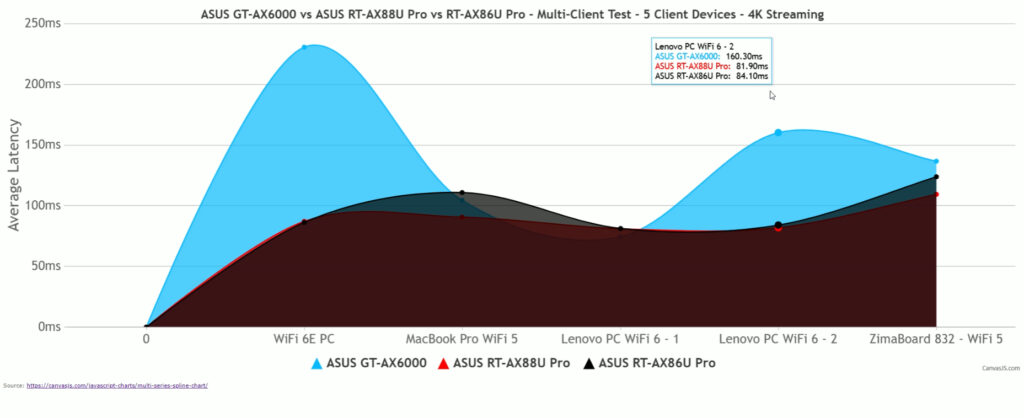
The RT-AX88U Pro and the RT-AX86U Pro could have been better, but the user will still experience some buffering. After adding intense browsing into the mix, I noticed that things evened out between the three WiFi 6 routers.
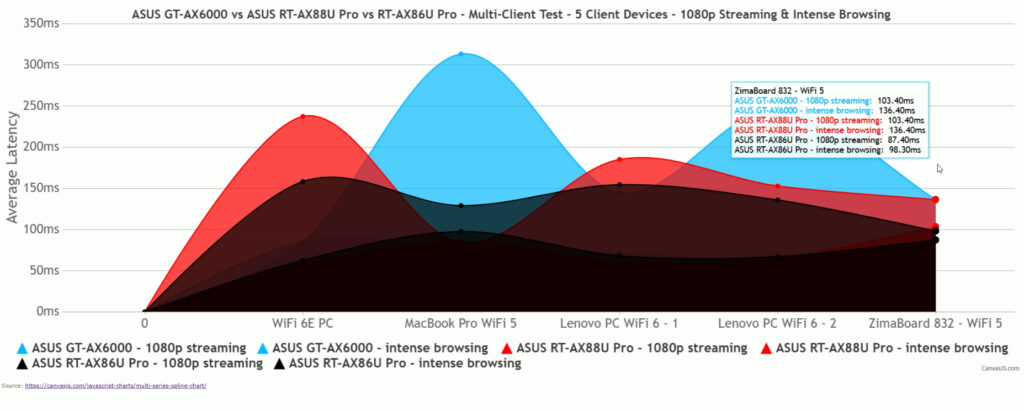
Understand that all of these types of traffic ran at the same time and the 1080p performance very close to 60ms on the WiFi 6 and 6E clients (the GT-AX6000 showing a small exception there).
After I also showed the intense browsing, we get to see that the winner is so far the RT-AX86U Pro with the close second being the RT-AX88U Pro. Moving to the 4K streaming and the intense browsing, we get between 80 and 100ms across all five clients with all three WiFi 6 routers which is usable, but far from ideal.
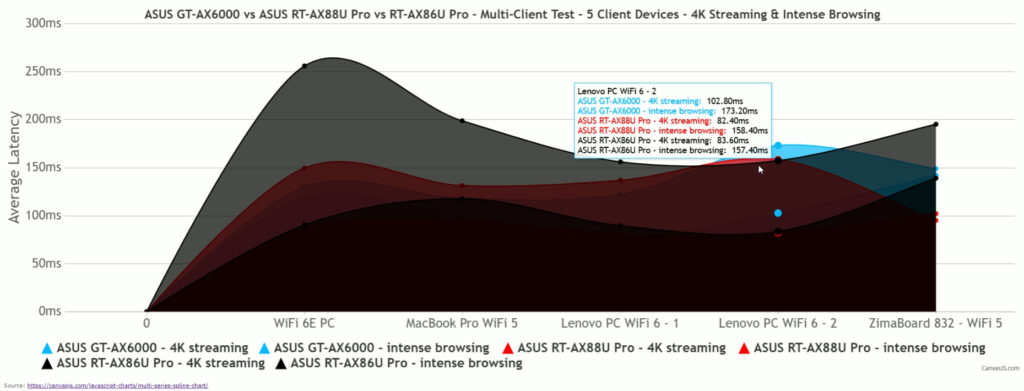
After including the intense browsing, we can see that the RT-AX86U Pro is no longer the best, the GT-AX6000 and the RT-AX88U Pro showing overall a better latency. So, after all these results, which is the better performer? It depends.
The single client tests crown the ROG GT-AX6000, while the multi-client tests are a bit more nuanced. To a certain point because the RT-AX88U Pro and the RT-AX86U pro definitely handled multiple clients a bit better.
The Software
There’s usually not a lot of difference between the ASUs routers in terms of settings and the software layout, but the ROG series does stand out with a different color palette and, sometimes more gaming-focused features. Also, ASUS has kept the VLAN and the Guest Network Pro locked away from The RT-AX86U Pro up until a few days ago when a new firmware upgrade finally unlocked it.
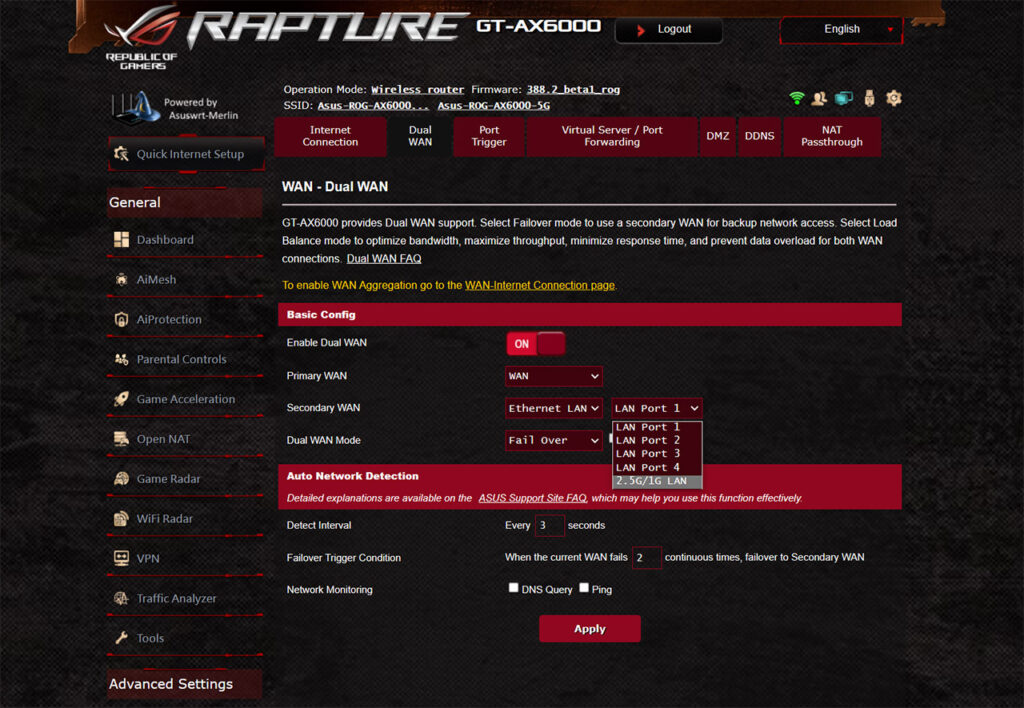
With that in mind, there isn’t a whole lot of difference between the RT-AX86U Pro and the RT-AX88U Pro. Both have the same software layout, there’s AiProtection on both, same VPN support and as for gaming features, there’s Game Boost, Mobile Game Mode and the Open NAT.
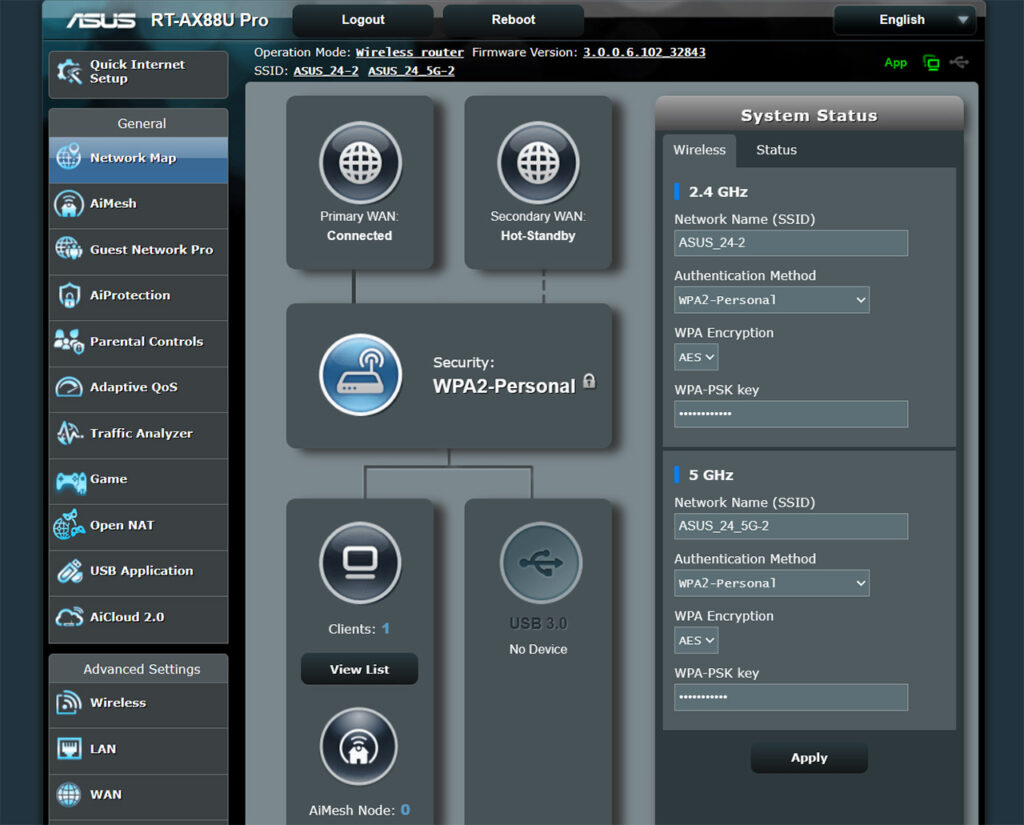
It seems that the WTFast GPN is only present on the RT-AX88U Pro and the GT-AX6000, and these two routers pretty much share the entire suite of available advanced features. So what’s the deal with the ROG name? You get flashy LEDs and black and red in the app and interface.

Speaking of the app, the main difference between what you get on the ROG GT-AX6000 and the RT-AX88U Pro, as well as the RT-AX86U Pro is again, the color palette.
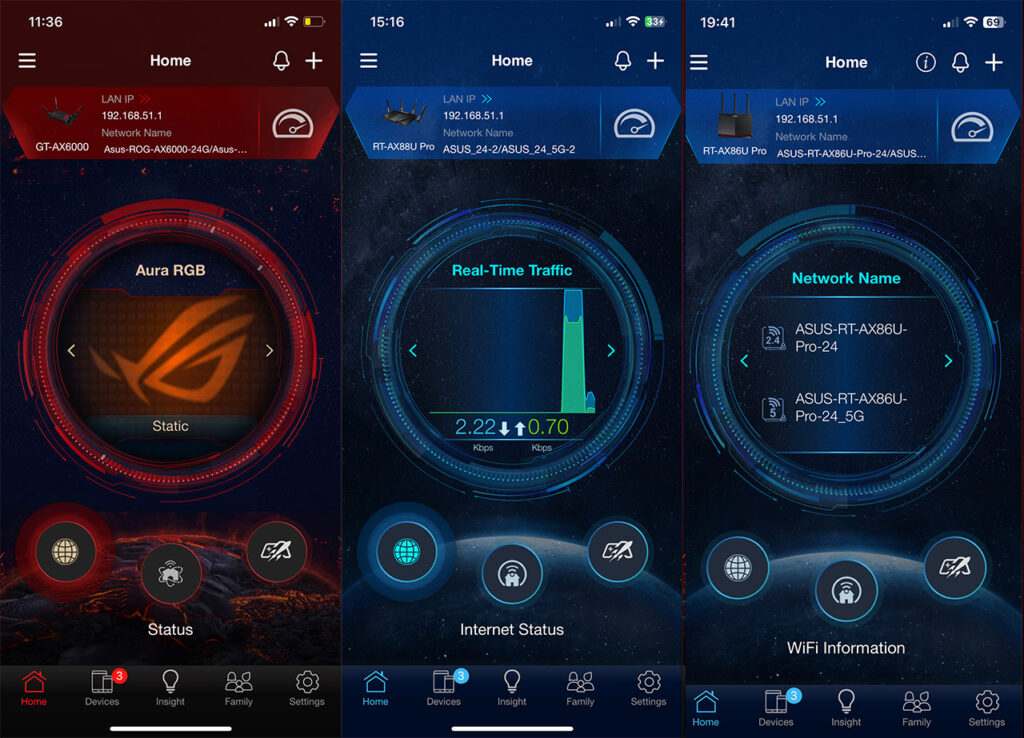
One last important factor is the support for open source and all three allow the installation of Merlin. But what about OpenWRT? Unfortunately none support it and the closest we can come in terms of performance is the TUF-AX6000 and the TUF-AX4200 duo. I actually tested the last one and OpenWRT worked really well.
The Conclusion
So there you have it, in terms of hardware and design, each has its own small advantage, such as the narrower footprint, slightly better thermals or the ability to be mounted on the wall. But in terms of performance, the routers do distance themselves a bit. The 2.4GHz radio chip of the RT-AX86U Pro does make a difference and not in the good sense, but it does hold its ground fairly well against the other two routers especially in the multi-client tests. the ROG GT-AX6000 does go head to head in almost every department with the RT-AX88U Pro, but I am fairly sure its design may put some people off. Also, it’s quite a bit older than the other two routers. So, if I were to choose between the three, I would say whichever is the cheapest between the RT-AX88U Pro and the RT-AX86U Pro.
